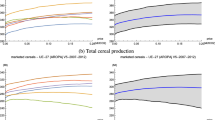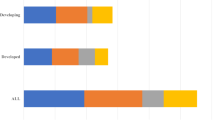Abstract
Agriculture is responsible for 25–30% of global anthropogenic greenhouse gas (GHG) emissions but has thus far been largely exempted from climate policies. Because of high monitoring costs and comparatively low technical potential for emission reductions in the agricultural sector, output taxes on emission-intensive agricultural goods may be an efficient policy instrument to deal with agricultural GHG emissions. In this study we assess the emission mitigation potential of GHG weighted consumption taxes on animal food products in the EU. We also estimate the decrease in agricultural land area through the related changes in food production and the additional mitigation potential in devoting this land to bioenergy production. Estimates are based on a model of food consumption and the related land use and GHG emissions in the EU. Results indicate that agricultural emissions in the EU27 can be reduced by approximately 32 million tons of CO2-eq with a GHG weighted tax on animal food products corresponding to €60 per ton CO2-eq. The effect of the tax is estimated to be six times higher if lignocellulosic crops are grown on the land made available and used to substitute for coal in power generation. Most of the effect of a GHG weighted tax on animal food can be captured by taxing the consumption of ruminant meat alone.
Similar content being viewed by others
References
Aiking HE, de Boer JE, Vereijken JE (2006) Sustainable protein production and consumption: pigs or peas? Springer, Dordrecht
Allais O, Nichèle V (2007) Capturing structural change in French meat and fish demand over the period 1991–2002. Eur Rev Agric Econ 34:517–538
Angervall T, Sonesson U, Ziegler F, Cederberg C (2008) Mat och klimat. En sammanfattning om matens klimatpåverkan i ett livscykelperspektiv. SIK, Göteborg
Basset-Mens C, van der Werf HMG (2005) Scenario-based environmental assessment of farming systems: the case of pig production in France. Agric Ecosyst Environ 105(1–2):127–144
Beach RH, DeAngelo BJ, Rose S, Li C, Salas W, DelGrosso SJ (2008) Mitigation potential and costs for global agricultural greenhouse gas emissions. Agric Econ 38(2):109–115
Bouwman AF, Boumans LJM (2002) Emissions of N2O and NO from fertilized fields: summary of available measurement data. Glob Biogeochem Cycles 16(4):1058
Burton M, Young T (1992) The structure of changing tastes for meat and fish in Great Britain. Eur Rev Agric Econ 19:165–180
Capper Jl, Cady RA, Bauman DE (2009) The environmental impact of dairy production: 1944 compared with 2007. Am Soc Anim Sci 87:2160–2167
Carpentier A, Guyomard H (2001) Unconditional elasticities in two-stage demand systems: an approximate solution. Am J Agric Econ 83(1):222–229
Casey JW, Holden NM (2005a) Analysis of greenhouse gas emissions from the average Irish milk production system. Agric Syst 86(1):97–114
Casey JW, Holden NM (2005b) Greenhouse gas emissions from conventional, agri-environmental scheme, and organic Irish Suckler-Beef units. Department of Biosystems Engineering (Bioresources Modelling Group), University College Dublin
Cederberg C, Darelius K (2000) Livscykelanalys (LCA) av nötkött -en studie av olika produktionsformer, Landstinget Halland
Cederberg C, Darelius K (2001) Livscykelanalys (LCA) av griskött, Naturresursforum, Landstinget Halland
Cederberg C, Mattsson B (2000) Life cycle assessment of milk production—a comparison of conventional and organic farming. J Clean Prod 8(1):49–60
Cederberg C, Nilsson B (2004) Miljösystemanalys av ekologiskt griskött. The Swedish Institute for Food and Biotechnology (SIK), Göteborg
Cederberg C, Stadig M (2003) System expansion and allocation in life cycle assessment of milk and beef production. Int J Life Cycle Assess 8(6):7
Cederberg C, Sonesson U, Henriksson M, Sund V, Davis J (2009a) Greenhouse gas emissions from production of meat, milk and eggs in Sweden 1990 and 2005. SIK-report 793, SIK - the Swedish Institute for Food and Biotechnology, Gothemburg
Cederberg C, Neovius K, Meyer D, Flysjö A (2009b) Top-down life cycle accounting of greenhouse gas emissions and use of land and energy of Brazilian beef exported to Europe, The Swedish Institute for Food and Biotechnology (SIK), Göteborg
EC (2006) Fourth National Communication from the European Community under the UN Framework Convention on Climate Change. SEC (2006) 138/2. Commission of the European Communities (EC), Brussels
Edwards R, Larivé JF (2007) Well-to-Wheels analysis of future automotive fuels and powertrains in the European context—Well-to-Tank report. EUCAR, CONCAWE, JRC/IES
EUROSTAT (2008) EUROSTAT Statistical Databases. European Commission, Brussels
FAOSTAT (2008) FAOSTAT Statistical Databases. FAO, Rome
Fousekis P, Revell B (2000) Meat demand in the UK: a differential approach. J Agric Appl Econ 32:11–19
Fraser I, Moosa IA (2002) Demand estimation in the presence of stochastic trend and seasonality: The case of meat demand in the United Kingdom. Am J Agric Econ 84:83–89
Garnett T (2007) Meat and dairy production and consumption—exploring the livestock sector’s contribution to the UK’s greenhouse gas emissions and assessing what less greenhouse gas intensive systems of production and consumption might look like. Food Climate Research Network
Houghton RA (1999) The annual net flux of carbon to the atmosphere from changes in land use 1850–1990. Tellus Ser B Chem Phys Meteorol 51(2):298–313
IPCC (2006) 2006 IPCC guidelines for national greenhouse gas inventories. In: Eggleston HS, Buendia L, Miwa K, Ngara T, Tanabe K (eds) Prepared by the national greenhouse gas inventories programme. IGES, Japan
IPCC (2007) Climate change 2007: mitigation. In: Metz B, Davidson OR, Bosch PR, Dave R, Meyer LA (eds) Contribution of working group III to the fourth assessment report of the intergovernmental panel on climate change. Cambridge University Press, Cambridge, United Kingdom and New York, NY, USA
Jones MB, Donnelly A (2004) Carbon sequestration in temperate grassland ecosystems and the influence of management, climate and elevated CO2. New Phytol 1(64):423–439
Karagiannis G, Katranidis S, Velentzas K (2000) An error correction almost ideal demand system for meat in Greece. Agric Econ 22:29–35
Koungshaug G (1998) Energy consumption and greenhouse gas emissions in fertilizer production. IFA Technical Conference, 28 Sept–1 Oct 1998, Marrakech, Morocco
Lal R (2004) Carbon emission from farm operations. Environ Int 30(7):981–990
Lassey KR (2007) Livestock methane emission: From the individual grazing animal through national inventories to the global methane cycle. Agric For Meteorol 142(2–4):120–132
Londo HM, Lensink SM, Deurwaarder EP, Wakker A, de Wit MP, Junginger HMK, Jungmeier G (2008) Biofuels cost developments in the EU27+ until 2030—Full-chain cost assessment and implications of policy options. REFUEL WP4 final report. ECN, Petten
Lovett DK, Shalloo L, Dillon P, O’Mara FP (2006) A systems approach to quantify greenhouse gas fluxes from pastoral dairy production as affected by management regime. Agric Syst 88(2–3):156–179
Manne AS, Richels RG (2001) An alternative approach to establishing trade-offs among greenhouse gases. Nature 410:675–677
McAlpine CA, Etter A, Fearnside PM, Seabrook L, Laurance WF (2009) Increasing world consumption of beef as a driver of regional and global change: a call for policy action based on evidence from Queensland (Australia), Colombia and Brazil (to appear in Global Environmental Change)
Nemry F, Theunis J, Breceht TH, Lopez P (2001) Greenhouse gas emissions reduction and material flows, Federal Office for Sciencific. Technical and Cultural Affairs, Brussels
Povellato A, Bosello F, Giupponi C (2007) Cost-effectiveness of greenhouse gases mitigation measures in the European agro-forestry sector: a literature survey. Environ Sci Policy 10(5):474–490
Reilly J, Prinn R, Harnisch J, Fitzmaurice J, Jacoby H, Kicklighter D, Melillo J, Stone P, Skolov A, Wang C (1999) Multi-gas assessment of the Kyoto Protocol. Nature 401:549–555
Schmutzler A, Goulder LH (1997) The choice between emission taxes and output taxes under imperfect monitoring. J Environ Econ Manage 32(1):51–64
Searchinger T, Heimlich R, Houghton RA, Dong FX, Elobeid A, Fabiosa J, Tokgoz S, Hayes D, Yu TH (2008) Use of US croplands for biofuels increases greenhouse gases through emissions from land-use change. Science 319:1238–1240
Smith P, Martino D, Cai Z, Gwary D, Janzen H, Kumar P, McCarl B, Ogle S, O’Mara F, Rice C, Scholes B, Sirotenko O, Howden M, McAllister T, Pan G, Romanenkov V, Schneider U, Towprayoon S, Wattenbach M, Smith J (2008) Greenhouse gas mitigation in agriculture. Phil Trans R Soc B 363:789–813
Snyder CS, Bruulsema TW, Jensen TL, Fixen PE (2009) Review of greenhouse gas emissions from crop productions systems and fertilizer management effects. Agric Ecosyst Environ 133:247–266
Soussana JF, Allard V, Pilegaard K, Ambus P, Amman C, Campbell C, Ceschia E, Clifton-Brown J, Czobel S, Domingues R, Flechard C, Fuhrer J, Hensen A, Horvath L, Jones M, Kasper G, Martin C, Nagy Z, Neftel A, Raschi A, Baronti S, Rees RM, Skiba U, Stefani P, Manca G, Sutton M, Tuba Z, Valentini R (2007) Full accounting of the greenhouse gas (CO2, N2O, CH4) budget of nine European grassland sites. Agric Ecosyst Environ 121:121–134
Stehfest E, Bouwman L, van Vuuren DP, den Elzen MGJ, Eickhout B, Kabat P (2009) Climate benefits of changing diet. Clim Change 95(1–2):83–102
Steinfeld H, Gerber P, Wassenaar T, Castel V, Rosales M, de Haan C (2006) Livestock’s long shadow-environmental issues and options. FAO, Rome
Thomassen MA, van Calker KJ, Smits MCJ, Iepema GL, de Boer IJM (2008) Life cycle assessment of conventional and organic milk production in the Netherlands. Agric Syst 96(1–3):95–107
USDA (2008a) EU-27 Livestock and products. Annual 2008. USDA Foreign Agriculture Service GAIN Report E48094
USDA (2008b) EU-27 Dairy and products. Annual 2008. USDA Foreign Agriculture Service GAIN Report E48116
USDA (2008c) EU-27 Poultry and products. Annual 2008. USDA Foreign Agriculture Service GAIN Report E48090
Vergé X, Dyer J, Desjardins R, Worth D (2009) Greenhouse gas emissions from the Canadian pork industry. Livest Sci 121(1):92–101
Weyant JP, De la Chesnaye FC, Blanford GJ (2006) Overview of EMF-21: multigas mitigation and climate policy. Energy J 27:1–32
Williams AG, Audsley E, Sandars DL (2006) Determining the environmental burdens and resource use in the production of agricultural and horticultural commodities. Silsoe Research Institute, Cranfield University
Wirsenius S (2000) Human use of land and organic materials: modeling the turnover of biomass in the global food system, PhD Thesis, Chalmers University of Technology, Göteborg
Wirsenius S (2003) The biomass metabolism of the global food system: a model-based survey of the global and regional turnover of food biomass. J Ind Ecol 7(1):47–80
Wirsenius S, Hedenus F (2010) Policy strategies for a sustainable food system: options for protecting the climate. In: Webster J, D’Silva J (eds) The crisis in meat and dairy consumption: developing a sustainable and greener future. Earthscan, London
Wirsenius S, Berndes G, Azar C (2010) How much land is needed for global food production under scenarios of dietary changes and livestock productivity increases in 2030? Agric Syst 103:621–636. doi:10.1016/j.agsy.2010.07.005
Author information
Authors and Affiliations
Corresponding author
Rights and permissions
About this article
Cite this article
Wirsenius, S., Hedenus, F. & Mohlin, K. Greenhouse gas taxes on animal food products: rationale, tax scheme and climate mitigation effects. Climatic Change 108, 159–184 (2011). https://doi.org/10.1007/s10584-010-9971-x
Received:
Accepted:
Published:
Issue Date:
DOI: https://doi.org/10.1007/s10584-010-9971-x




